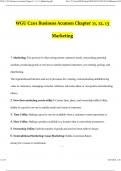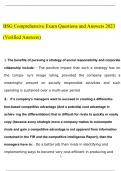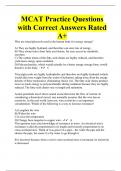WGU C201 Business Acumen Chapter 11, 12, 13 Marketing.pdf file:///C:/Users/HP/Desktop/NIW/WGU%20C201%20Business%20
WGU C201 Business Acumen Chapter 11, 12, 13
Marketing
1. Marketing: The process for discovering unmet customer needs, researching potential
markets, producing goods or services to satisfy targeted customers, pro-moting, pricing, and
distributing.
The organizational function and set of processes for creating, communicating anddelivering
value to customers, managing customer relations, advocates ideas or viewpoints and educating
others.
2. How does marketing create utility?: Creates time, place, and ownership utility.Utility:
ability of a good or service to satisfy needs and wants of customer.
3. Time Utility: Making a good or service available when a customer wants topurchase it.
4. Place Utility: Making a product available in a location that is convenient tocustomer.
5. Ownership Utility: Orderly transfer of goods and services from seller to buyer.
6. Nontraditional Marketing: Cause Marketing: Builds awareness.Raises
money for a cause or social issue.
1 of 27 8/20/2024, 1:26
,WGU C201 Business Acumen Chapter 11, 12, 13 Marketing.pdf file:///C:/Users/HP/Desktop/NIW/WGU%20C201%20Business%20
Examples: American Cancer Society, Drug Abuse Prevention, Childhood Hunger,Alternative
Spring Break
7. Nontraditional Marketing: Place Marketing: Attracts people to a specific place.Examples:
Commercials that promote tourism to specific states.
8. Nontraditional Marketing: Event Marketing: Cultural or charitable perfor-mances,
athletic competitions, often forges partnership with for profit sponsor. Examples: Major
League Baseball Games, World Series
9. Nontraditional Marketing: Person Marketing: Attracts attention, interest, pref-erence of
target market toward person.
Examples: Allison Krauss, political campaign, job seekers.
10. Nontraditional Marketing: Organization Marketing: Influences consumers toaccept
goals of receiving services of, or a contribution to organization.
Seeks to connect with an audience that is most likely to offer time, money, orresources.
Examples: WGU, Postal Service, Army
11. 2 Step Process to Develop a Marketing Strategy: 1. Collecting Data
2. Evaluating Data (Data mining)
12. Sources of Research Data: Internal: Within organization
Examples:financial documents and records, unpaid bills, inventory levels, sales fromdifferent
2 of 27 8/20/2024, 1:26
,WGU C201 Business Acumen Chapter 11, 12, 13 Marketing.pdf file:///C:/Users/HP/Desktop/NIW/WGU%20C201%20Business%20
categories.
13. Sources of Research Data: External: primary and secondary data
14. Primary Data: Data collected first hand: observation, surveys, focus groups,social media
activity
3 of 27 8/20/2024, 1:26






